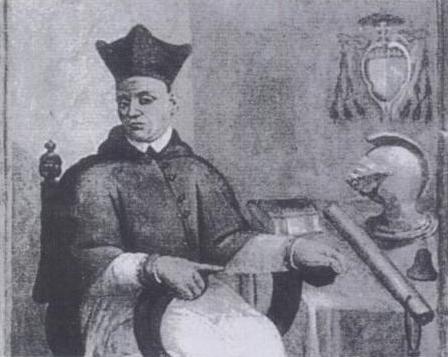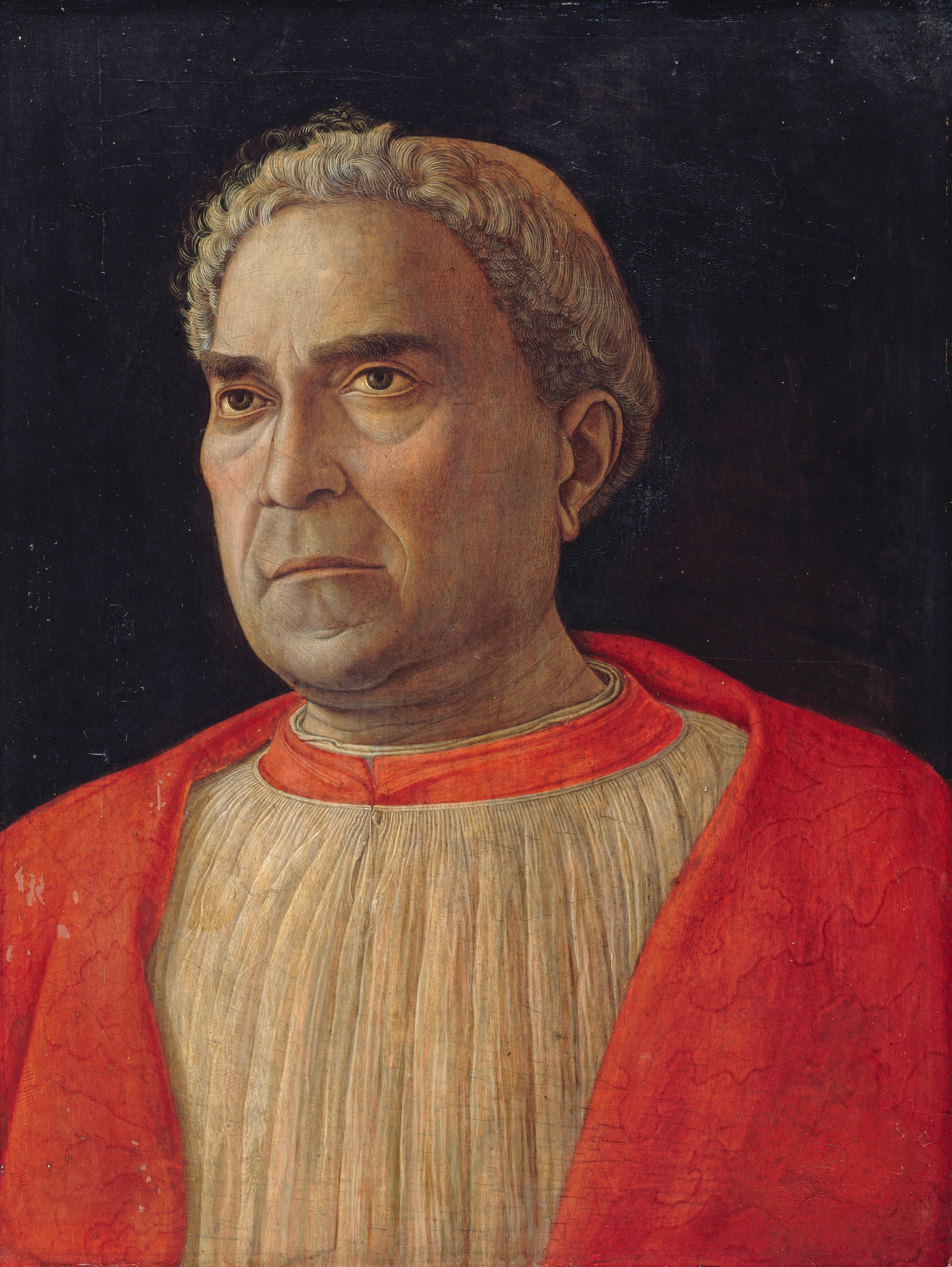|
Giovanni Vitelleschi
Giovanni Maria Vitelleschi (1396 – 2 April 1440) was an Italian cardinal and condottiere. Biography Vitelleschi was born in Corneto (modern Tarquinia, then part of the Papal States), some kilometers north to Rome. He received a military education, which he refined as apostolic protonotary under Pope Martin V. The fighting bishop of Recanati from 1431, and afterwards made a cardinal, he was commander of the papal armies of Pope Eugene IV when the Colonna faction at Rome, infuriated by the reversal of their fortunes when Eugene succeeded Martin V (a member of the Colonna), backed an insurrection that raised a temporary republic at Rome and forced Eugene into exile at Florence in May 1434. The city was restored to obedience by Giovanni Vitelleschi in the following October, in a display of ferocious cruelty. Vitelleschi abrogated all Roman rights and had the Roman Senate declare him ''tertius pater patriae post Romulum'' ("the third Father of his Country since Romulus"). He comma ... [...More Info...] [...Related Items...] OR: [Wikipedia] [Google] [Baidu] |
Foligno
Foligno (; Southern Umbrian: ''Fuligno'') is an ancient town of Italy in the province of Perugia in east central Umbria, on the Topino river where it leaves the Apennines and enters the wide plain of the Clitunno river system. It is located south-east of Perugia, north-north-west of Trevi and south of Spello. While Foligno is an active bishopric, one of its civil parishes, San Giovanni Profiamma, is the historical site of the former bishopric of Foro Flaminio, which remains a Latin Catholic titular see. Foligno railway station forms part of the main line from Rome to Ancona, and is the junction for Perugia; it is thus an important rail centre, with repair and maintenance yards for the trains of central Italy, and was therefore subjected to severe Allied aerial bombing in World War II, responsible for its relatively modern aspect, although it retains some medieval monuments. Of its Roman past no significant trace remains, with the exception of the regular street plan of the c ... [...More Info...] [...Related Items...] OR: [Wikipedia] [Google] [Baidu] |
Filippo Lippi
Filippo Lippi ( – 8 October 1469), also known as Lippo Lippi, was an Italian painter of the Quattrocento (15th century) and a Carmelite Priest. Biography Lippi was born in Florence in 1406 to Tommaso, a butcher, and his wife. He was orphaned when he was two years old and sent to live with his aunt Mona Lapaccia. Because she was too poor to rear him, she placed him in the neighboring Carmelite convent when he was eight years old. There, he started his education. In 1420 he was admitted to the community of Carmelite friars of the Priory of Our Lady of Mount Carmel in Florence, taking religious vows in the Order the following year, at the age of sixteen. He was ordained as a priest in approximately 1425 and remained in residence of that priory until 1432. Giorgio Vasari, the first art historian of the Renaissance, writes that Lippi was inspired to become a painter by watching Masaccio at work in the Carmine church. Lippi's early work, notably the Tarquinia Madonna (Galle ... [...More Info...] [...Related Items...] OR: [Wikipedia] [Google] [Baidu] |
Bishop Of Corneto And Montefiascone
The diocese of Montefiascone (''Latin Name: Faliscodunensis o Montis Falisci'') was a Catholic ecclesiastical territory in Italy. It was created from the diocese of Bagnorea in 1369. In 1986 was united into the diocese of Viterbo, Acquapendente, Bagnoregio, Montefiascone, Tuscania e San Martino al Monte Cimino."Diocese of Montefiascone" ''''. David M. Cheney. Retrieved February 29, 2016."Titular Episcopal See of Montefiascone" ''GCatholic.org''. Gabriel Chow. Retrieved Febr ... [...More Info...] [...Related Items...] OR: [Wikipedia] [Google] [Baidu] |
Ludovico Trevisan
Ludovico Trevisan (November 1401 – March 22, 1465) was an Italian catholic prelate, who was the Camerlengo of the Holy Roman Church, Patriarch of Aquileia and Captain General of the Church. He succeeded his rival Giovanni Vitelleschi, a fellow cardinal of military talent and inclination, as Bishop of Traù and Metropolitan Archbishop of Florence.Chambers, 2006, p. 45. Trevisan was also known as the Cardinal of Aquileia and the Cardinal Camerlengo. Early life Trevisan was born into a non-military family in Padua, then in the territory of the Republic of Venice, the son of Biagio Trevisano, a doctor in the arts and medicine.Miranda, Salvador. 1998.Consistory of July 1, 1440 (IV)" Like other war cardinals, such as Niccolò Fortiguerra and Giuliano della Rovere, Trevisan came from a humble background. His mother's maiden name was Mezzarota. His first name is sometimes also rendered Ludovico, Luigi, Luise, and Alvise; his last name as Trevisano or Scarampi-Mezzarota. Trevisan st ... [...More Info...] [...Related Items...] OR: [Wikipedia] [Google] [Baidu] |
Castel Sant'Angelo
The Mausoleum of Hadrian, usually known as Castel Sant'Angelo (; English: ''Castle of the Holy Angel''), is a towering cylindrical building in Parco Adriano, Rome, Italy. It was initially commissioned by the Roman Emperor Hadrian as a mausoleum for himself and his family. The building was later used by the popes as a fortress and castle, and is now a museum. The structure was once the tallest building in Rome. Hadrian's tomb The tomb of the Roman emperor Hadrian, also called Hadrian's mole, was erected on the right bank of the Tiber, between AD 134 and 139. Originally the mausoleum was a decorated cylinder, with a garden top and golden quadriga. Hadrian's ashes were placed here a year after his death in Baiae in 138, together with those of his wife Sabina, and his first adopted son, Lucius Aelius, who died in 138. Following this, the remains of succeeding emperors were also placed here, the last recorded deposition being Caracalla Marcus Aurelius Antoninus (born L ... [...More Info...] [...Related Items...] OR: [Wikipedia] [Google] [Baidu] |
Niccolò Piccinino
Niccolò Piccinino (1386 – 15 October 1444) was an Italian condottiero. Biography He was born in Perugia, the son of a butcher. Piccinino was introduced in the guild of Perugia's butchers. He was later scornfully called "son of a butcher" by Pope Pius II. However, Piccinino's family actually owned a house with a nearby butchery, and were part of the landed middle class, and, according to tradition, one of his uncles had been ''podestà'' of Milan. He began his military career in the service of Braccio da Montone, who at that time was waging war against Perugia on his own account, and at the death of his chief, shortly followed by that of the latter's son Oddo, Piccinino became leader of Braccio's ''condotta''. After serving for a short period under the Florentine Republic, he went over to Filippo Maria Visconti, duke of Milan (1425), in whose service together with Niccolò Fortebraccio he fought in the Wars in Lombardy against the league of Pope Eugene IV, Venice and Florence ... [...More Info...] [...Related Items...] OR: [Wikipedia] [Google] [Baidu] |
Kingdom Of Naples
The Kingdom of Naples ( la, Regnum Neapolitanum; it, Regno di Napoli; nap, Regno 'e Napule), also known as the Kingdom of Sicily, was a state that ruled the part of the Italian Peninsula south of the Papal States between 1282 and 1816. It was established by the War of the Sicilian Vespers (1282–1302), when the island of Sicily revolted and was conquered by the Crown of Aragon, becoming a separate kingdom also called the Kingdom of Sicily. In 1816, it reunified with the island of Sicily to form the Kingdom of the Two Sicilies. The territory of the Kingdom of Naples corresponded to the current Italian regions of Campania, Calabria, Apulia, Basilicata, Abruzzo, Molise and also included some areas of today's southern and eastern Lazio. Nomenclature The term "Kingdom of Naples" is in near-universal use among historians, but it was not used officially by the government. Since the Angevins remained in power on the Italian peninsula, they kept the original name of the Kingdom ... [...More Info...] [...Related Items...] OR: [Wikipedia] [Google] [Baidu] |
Romagna
Romagna ( rgn, Rumâgna) is an Italian historical region that approximately corresponds to the south-eastern portion of present-day Emilia-Romagna, North Italy. Traditionally, it is limited by the Apennines to the south-west, the Adriatic to the east, and the rivers Reno and Sillaro to the north and west. The region's major cities include Cesena, Faenza, Forlì, Imola, Ravenna, Rimini and City of San Marino (San Marino is a landlocked state inside the Romagna historical region). The region has been recently formally expanded with the transfer from the Marche region of nine comuni where the Romagnol language is spoken (Casteldelci, Maiolo, Novafeltria, Pennabilli, San Leo, Sant'Agata Feltria, Talamello, Montecopiolo, Sassofeltrio). Etymology The name ''Romagna'' originates from the Latin name ''Romania'', which originally was the generic name for "land inhabited by Romans", and first appeared on Latin documents in the 5th century. It later took on the more specific meaning of " ... [...More Info...] [...Related Items...] OR: [Wikipedia] [Google] [Baidu] |
Tuscany
Tuscany ( ; it, Toscana ) is a Regions of Italy, region in central Italy with an area of about and a population of about 3.8 million inhabitants. The regional capital is Florence (''Firenze''). Tuscany is known for its landscapes, history, artistic legacy, and its influence on high culture. It is regarded as the birthplace of the Italian Renaissance and of the foundations of the Italian language. The prestige established by the Tuscan dialect's use in literature by Dante Alighieri, Petrarch, Giovanni Boccaccio, Niccolò Machiavelli and Francesco Guicciardini led to its subsequent elaboration as the language of culture throughout Italy. It has been home to many figures influential in the history of art and science, and contains well-known museums such as the Uffizi and the Palazzo Pitti. Tuscany is also known for its wines, including Chianti, Vino Nobile di Montepulciano, Morellino di Scansano, Brunello di Montalcino and white Vernaccia di San Gimignano. Having a strong linguisti ... [...More Info...] [...Related Items...] OR: [Wikipedia] [Google] [Baidu] |
Niccolò Machiavelli
Niccolò di Bernardo dei Machiavelli ( , , ; 3 May 1469 – 21 June 1527), occasionally rendered in English as Nicholas Machiavel ( , ; see below), was an Italian diplomat, author, philosopher and historian who lived during the Renaissance. He is best known for his political treatise ''The Prince'' (''Il Principe''), written in about 1513 but not published until 1532. He has often been called the father of modern political philosophy and political science. For many years he served as a senior official in the Florentine Republic with responsibilities in diplomatic and military affairs. He wrote comedies, carnival songs, and poetry. His personal correspondence is also important to historians and scholars of Italian correspondence. He worked as secretary to the Second Chancery of the Republic of Florence from 1498 to 1512, when the Medici were out of power. After his death Machiavelli's name came to evoke unscrupulous acts of the sort he advised most famously in his work, ''T ... [...More Info...] [...Related Items...] OR: [Wikipedia] [Google] [Baidu] |
Archbishop Of Florence
The Archdiocese of Florence ( la, Archidioecesis Florentina) is a metropolitan see of the Catholic Church in Italy."Archdiocese of Firenze " ''''. David M. Cheney. Retrieved 7 October 2016."Metropolitan Archdiocese of Firenze" ''GCatholic.org''. Gabriel Chow. Retrieved October 7, 2016. It was traditionally founded in the 1st century, according to the 14th century chronicler |







